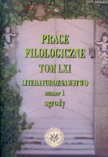Ogrody Stiftera
Stifter’s Gardens
Author(s): Aneta MazurSubject(s): Literary Texts
Published by: Wydział Polonistyki Uniwersytetu Warszawskiego
Keywords: ogród; Adalbert Stifter; garden; Adalbert Stifter
Summary/Abstract: The article deals with the motif of garden in the work of Adalbert Stifter (1805-1868), an eminent author of Austrian Biedermeier prose, but also an inheritor of German classicism. Pictorial garden space plays a very important role in the plot and characters’ configurations in several Stifter’s short stories and novels (among others: {Colorful Stones}, {Brigitta}, {Two Sisters}, {The Wanderer in the Forest}, {Indian Summer}). The Garden, natural border-space between nature and civilization, evocates the condition of mental and primary ethical order, which is typical of Biedermeier style. Three dimensions of the motif are to be discussed: garden as the icon of development and inner growth of an individual ({Bildung} tradition); garden as love scenery and place of decline (Bible allegory) and garden as {oeconomia divina} (i.e. divine order of natural wildness, which can be destroyed by man’s {hybris} - or human order of artificial wildness, which represents existential and metaphysical harmony of human life). There are plenty of classical, biblical, romantic and modern topoi that create poetical topography of Stifter’s garden, among them: Arcadia, {locus amoenus}, Eden, {hortus conclusus}, Rose’s Garden of Love, Utopia, idyll, pantheistic and contemplative vision of nature, “atmosphere” and impression, ecology idea. Due to this, the garden motif in Stifter’s work corresponds perfectly to his philosophical conception (known as Gentle Law, {das sanfte Gesetz}), which explains the world as a kind of natural and cultural unity.
Journal: Prace Filologiczne. Literaturoznawstwo [PFLIT]
- Issue Year: 2011
- Issue No: 1 (4)
- Page Range: 247-268
- Page Count: 22
- Language: Polish

